Nine days with cohort 9

The ninth cohort of graduate students at North Cascades Institute finished their first quarter of graduate school with a nine-day backpacking trip across the North Cascade mountain range.  Each student reflected upon one day of the trip to create this summary of their adventure.
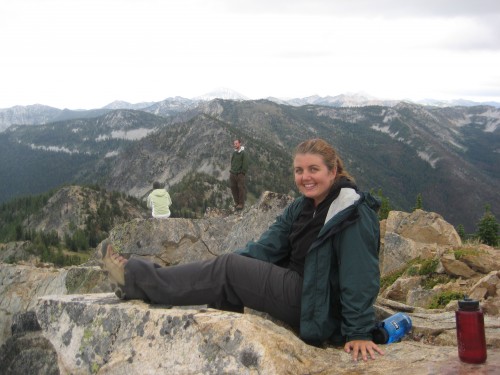 Brandi Stewart on Boulder Butte
Brandi Stewart on Boulder Butte
Day 1 – by Brandi Stewart
After a “business” lunch at Washington Pass discussing climate change and its effects on the North Cascades, Cohort 9 began their journey near Twisp at the War Creek trailhead. A CCC-era cabin greeted the group after a gradual five-mile hike–the first few thousand steps of their journey. Stoves humming, dinner was made in great spirits followed by one of many discussions on wilderness. Some retired to their tents, while others decided to bunk in the cabin. In the middle of the night, these grads were stirred awake by the current tenants of the aging cabin–scurrying mice hoping for errant scraps of the previous meal.
Day Two – by Kelsi Franzen
The morning of the second day greeted our cohort with hot oats and coffee, overcast skies and warm temperatures. With 2300 feet of elevation to gain over five miles, and packs still freshly heavy on our backs, we poked our way up the War Creek drainage. Evidence of a lightning-derived forest fire was all around, as ponderosa pines gave way to alpine larch and englemann spruce, with hints of fireweed and lupine interspersed in pockets of exposed meadows.
Nearing War Creek Pass, tall, smooth-cut slabs of rock indicated to us of harsh winters, and talus slopes abounded. A sign entitled “Lake Chelan Sawtooth Wilderness†greeted us as we walked another half-mile to our next camp, Juanita Lake. We could hear the whistles and see the scampering of at least four marmots, curiously checking us out, as we set up camp.
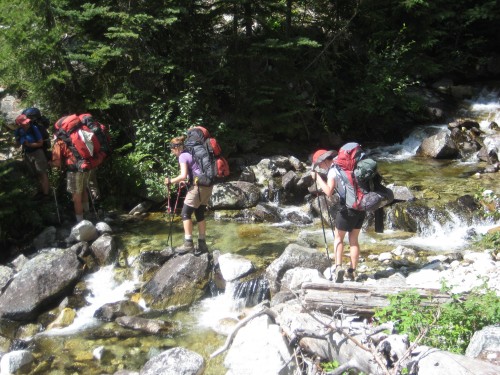 Stream crossing
Stream crossing
After a brief period of downtime, we gathered together as a group to hike an additional mile to Boulder Butte, our highest point reached during the entire trip. “Krumholz†white bark pine trees, literally meaning twisted or bent in German, reached up to darkening skies as we traversed across rocky slopes composed of basalt and diorite. Small clumps of native bunchgrasses peaked out from cracks in the rocks, while some of us had some close encounters with the rare and wonderful mountain bluebirds.
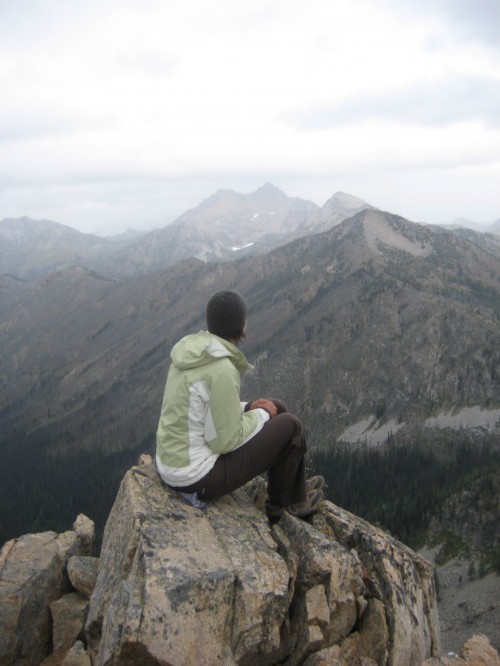 Megan Magee sits atop Boulder Butte
Megan Magee sits atop Boulder Butte
At 7300 feet, Boulder Butte once housed a fire lookout that had communication wires stretching all the way down the War Creek drainage ten miles away. Once at the top, our group posed for photographs and awed at the surrounding topographic features. Lake Chelan’s northwestern shores lay nearly 6000 feet below us to the west, while Mt. Reynolds stood looming over us to the northeast. The chill of a high altitude wind kept us on the summit only for a few minutes, our views becoming less and less defined as the western Cascade peaks disappeared behind a veil of rain showers.
Later that evening, after tasty dinners composed of rice and bean tortillas and Cory’s “pasta heaven†mixture, Kelsi and Martine led discussions on the historical arguments for wilderness preservation from authors like Wallace Stegner. Sleep was deep that night, as rain on our tents serenaded us.
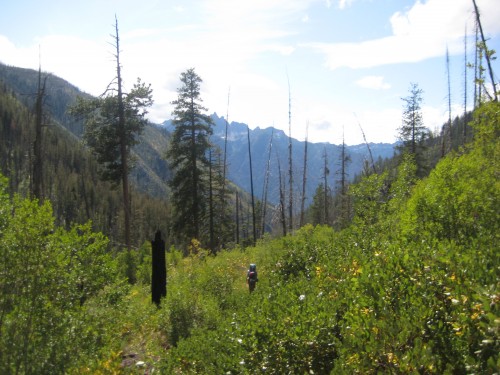 Hiking though a burn area
Hiking though a burn area
Day 3 – by Justin McWethy
We woke up to raindrops, clouds, and cold temperatures. It was difficult getting out of the tent, but once the coffee started flowing, the blood started pumping. Shortly after breakfast the clouds began to part and the rain stopped falling. We began the day of hiking by going up and over War Creek Pass and down the valley toward Stehekin. The long 11 miles down to the quaint mountain town was full of beautiful views, great conversations, and delicious berries. My personal highlight of the day was coming upon a huge batch of raspberry bushes. We all dropped our packs and foraged on the fantastic fruits for as long as our taste buds could handle. It was a great sight watching the group enjoy such a treat of nature. Finally, after miles of downhill and damaged feet, we came to our campsite. It was a challenge, the greatest the group had faced up to that point, but we overcame it with smiles on our faces.
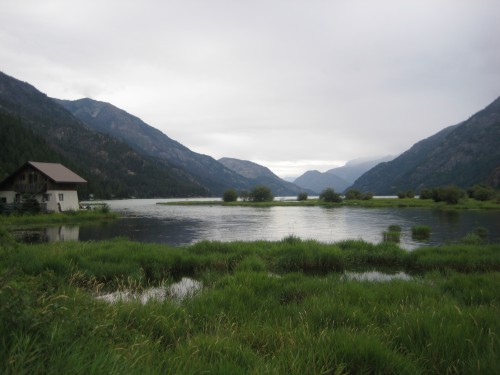 Lake Chelan
Lake Chelan
Day 4 – by Paul Wiemerslage
Day four found the group romping around the town of Stehekin. Native Americans utilized the Stehekin Valley as “a way through†to the Pacific Ocean; we utilized Stehekin for its bakery, bicycles, and beer. Our day was spent exploring the history of the unique town and its hardy inhabitants. We stopped by the one-room schoolhouse, wandered through the Buckner’s Orchard, and discussed the controversial relationship between the town and the Park Service. After some breathtaking views of Lake Chelan, Rainbow Falls and the Stehekin River we gorged ourselves on country-style dinners at the Stehekin Valley Ranch. As we settled in for the night we lay in preparation for our return to the trail, but also in thankfulness for the rest our day in Stehekin has provided us all.
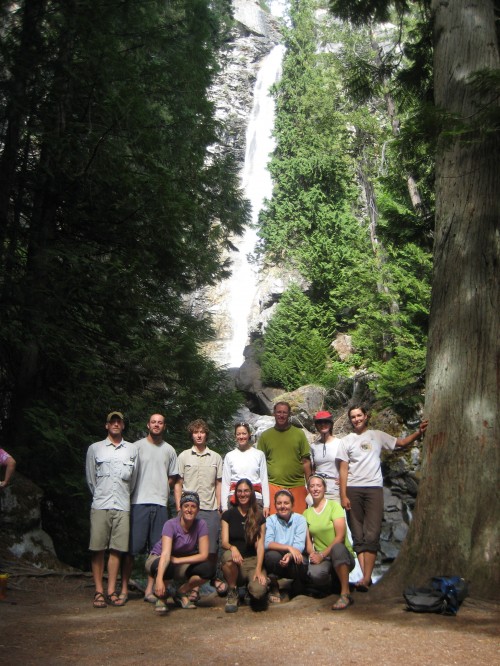 Cohort 9 at Rainbow Falls
Cohort 9 at Rainbow Falls
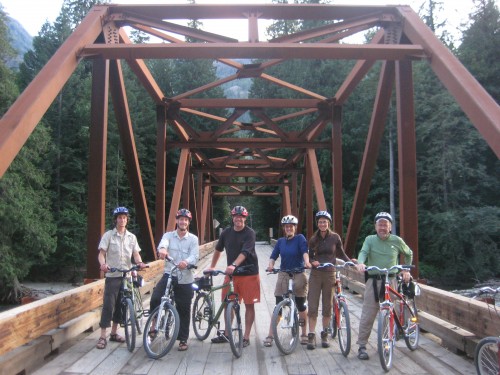 Biking in Stehekin
Biking in Stehekin
Day Five – by Mike Parelskin
We awoke in Stehekin and returned our bikes early enough to make one last stop at the bakery. I bade my favorite sticky bun farewell as I swallowed the last bite and washed it down with some strong coffee. We returned to camp, packed and waited for our shuttle to the trailhead to begin our climb out of the Stehekin Valley. Our destination: Flat Creek campground, up some not-so-flat trail. As I hiked up, my appetite grew as I groped for every berry I could get my sticky, purple, berry-stained fingers on. As I did this, I had a strange feeling I wasn’t the only one enjoying the plethora of ripe blueberries that day. As that thought started and began to be pushed out by the next, I stumbled upon a hulking mass of bear scat, full of berries, which I swear I could just about feel the heat from. Then I saw a second, third and fourth pile. It was indeed clear that I wasn’t just sharing these berries with my fellow cohort that day.
Day 6 – by Rebecca Ryan
Friday morning got off to a leisurely start, with a “sleep-in†morning and discussion before leaving Flat Creek around noon. The hike to Five Mile Camp gained elevation slowly, moving the group closer to Park Creek Pass. Throughout the hike and at camp, there were spectacular views of Buckner Glacier. A doe and fawn were around camp throughout the evening and night, hoping to lick the salt from sweaty clothes hung out to dry, backpack straps, and even the handles of trekking poles.
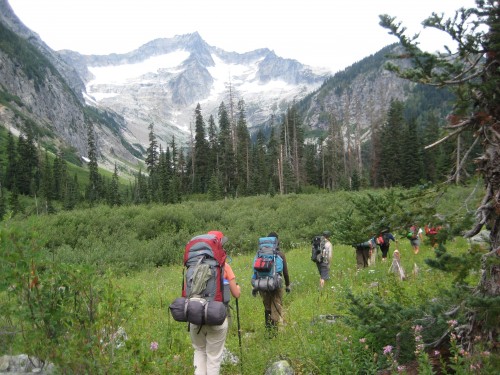 Hiking near the Buckner Glacier
Hiking near the Buckner Glacier
Day 7 – by Corey White
This second most ambitious day of the trip had us gaining 2,000 feet of elevation and then dropping 3,000 feet. These 8.5 miles took us over Park Creek Pass, connecting the Park Creek Valley with Thunder Basin. On our way up, conifers gradually gave way to alpine meadows which allowed majestic mountain views. Shrill marmot whistles announced our approach to the pass as the trail got increasingly rocky. Jutting and jagged mountain ridges and an occasional glacier greeted us as we traversed into Thunder Basin. At the bottom of the basin a 12-foot deep snowfield remained from an avalanche last winter. We picked our way through tree debris and down a snowfield wall to cross a creek that was undercutting a snowfield. Half an hour before reaching camp, a sub-group of our cohort disturbed a trailside nest of yellow jackets. Several of us got a sting apiece and one “lottery†winner received seven.
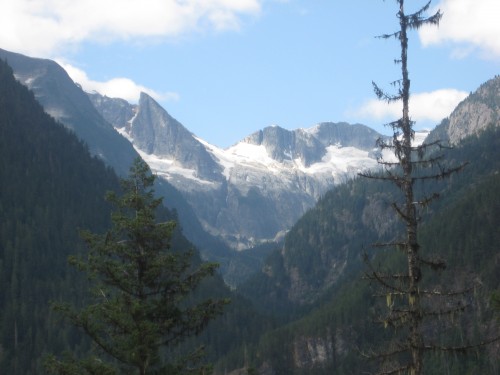 Spectacular views along Thunder Creek
Spectacular views along Thunder Creek
Day 8 – by Erin Fowler
We broke camp at 9 AM and left the mining site of Skagit Queen to follow the arm of Thunder Creek as it grew in size and turbulence. Our path meandered through groves strewn with moss and resting nurse logs. Periodically, a break in the trees to our left yielded excellent views of Tricone Peak and beyond to Shark Fin Peak. Peering down the mountainside upon which we stood, we could observe the vine maples acquiring reddening hues of autumn, even though we had run across ripening salmonberries the day we descended from Park Creek Pass.
McAllister Camp was reached at around 2 PM after a brief seven-mile hike, allowing us time to soak our feet in Thunder Creek, nap in our tents, catch up on reading, and poke around the campsite. The designated toilet was found in an open wooded area lit golden green, allowing for reflection while upon the toilet. Thunder Creek had reached a greater width, up to 40 feet, and was littered with boulders and driftwood. A water ouzel, also called the American dipper, was bobbing and darting into the torrential currents to glean its meals while upstream three juvenile harlequin ducks dived, splashed, and preened themselves, then proceeded to snuggle together on a boulder in midstream.
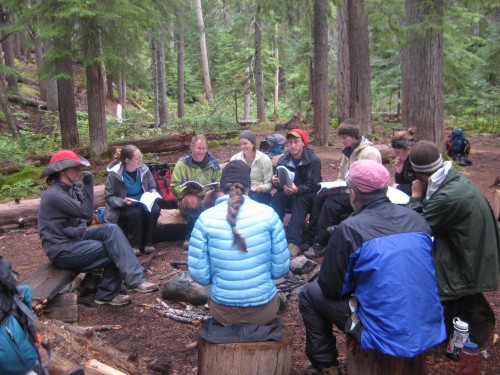 One of our many class discussions
One of our many class discussions
That evening’s discussion consisted of journaling exercises by Corey and Brandi. Corey’s lesson focused on identifying aspects of the trip with each of our five senses as well as discussing when each of us fully realized that we were in a wilderness area. Brandi led a discussion on components of wilderness values, uses, and benefits, then led us through an exercise on writing a diamond poem. We then exchanged closing remarks regarding the trip and momentous life events. Thus ended the last night of our trip together beneath the starry evening skies.
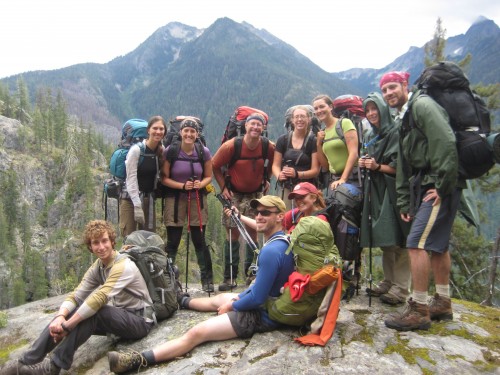 Cohort 9, happy on the trail
Cohort 9, happy on the trail
Day 9 – by Tanya Anderson
By the ninth day of the trip, we all had blisters and sore muscles. As a group, however, we worked like a well-oiled machine. We broke camp at 8 am and breezed down the Thunder Creek Trail, reaching our final destination an hour earlier than expected. We were greeted with news that there was plenty of lunch waiting for us at the Environmental Learning Center, and that we would be sleeping in beds again for the first time in over a week. We relaxed the rest of the day, and spent the evening stargazing on the shores of Diablo Lake.
To commemorate our adventure, we each wrote one line of this poem:
“Let us start an adventure, to wilderness, to nature,
We shall cross landscapes of wisdom beneath star-filled skies
And pass gas strong enough to kill the flies.
We cross passes, but never one another,
Always together, holding hands with each other.
Undaunted by sore knees and blisters that swell,
Not so fortunately today, we bid the trail farewell.
Goodbye for now, but we shall see you soon,
As we seek the dark chocolate skies we found under the new moon.
Because our adventure in the North Cascades is just beginning,
And we’ll hike more mountains and watch more sunsets dimming
For now, we’ll teach the kids and settle for swimming.â€


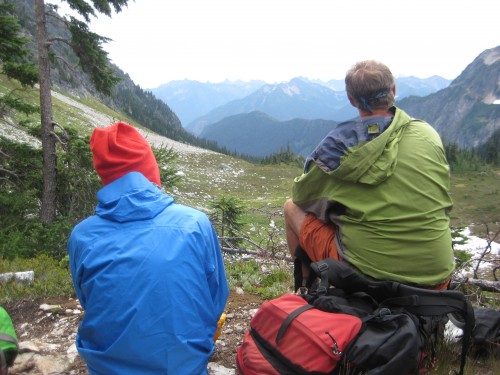 Corey White and professor John Miles reflect on their journey
Corey White and professor John Miles reflect on their journey
Congratulations Cohort 9 on a great adventure – thanks for sharing the stories and photos with us and look forward to more!
Welcome back from a great adventure. We are so looking forward to working with all of you this year!
Thanks to you all. You have eloquently described a great learning adventure. The learning and growing never stops out there!
The Leader Who (tries to be) Hardly Known
Great job everyone!
Excellent write-ups everyone! What a wonderful trip – living in and seeing the soul of the North Cascades. Very nice images Tanya.
Congrats all on what sounds like a great trip… the pictures and text brought back very precious memories for me..
We’re looking forward to having you guys at the ELC!
Thanks for the memories. I backpacked the North Cascades in the 1970’s. My favorite spot was Copper Ridge north of Mt. Challenger and Fury. Old Duffer
http://oldduffersnaturecinema.blogspot.com